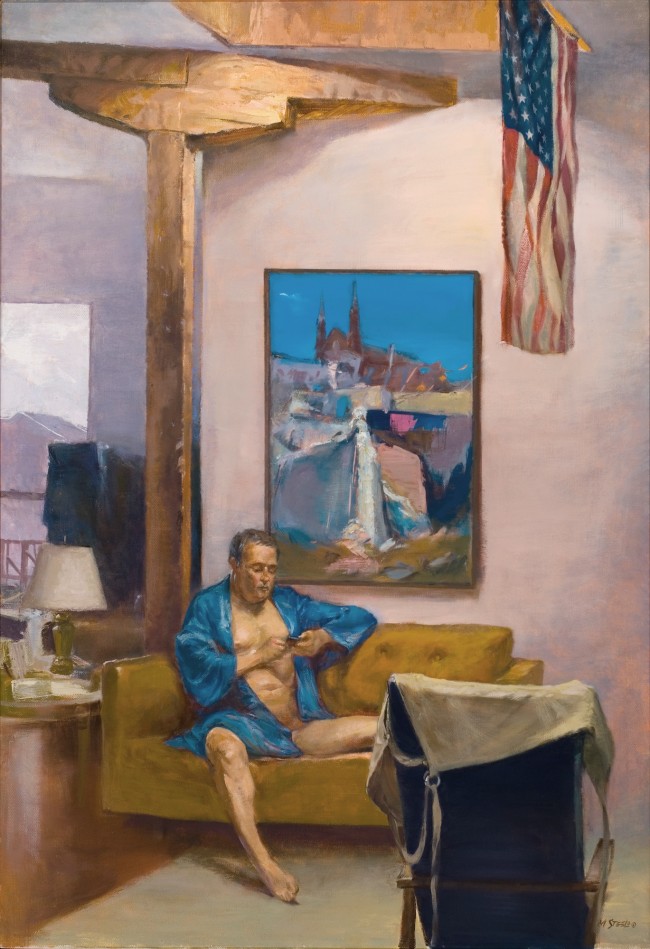DIS-SEMBLANCE:
PROJECTING AND PERCEIVING IDENTITY
By Marlene Steele
“We become what we behold. We shape our tools and then our tools shape us.”
— Marshall McLuhan
21C Museum Hotel Cincinnati, Cincinnati Ohio
A multi-national array of artists dissect with various technological innovations the contemporary, multicultural perception of portraiture today. This artist is reporting a selection of pieces viewed in the first floor galleries of this engaging exhibition.
Dominating the far walls of the main gallery are 2 works by American Kehinde Wiley. Both depict African American men in gestures both heroic and enticing. “Morpheus”, an oil canvas of monumental proportions, redefines hiphop culture through a reinterpretation of a classic odalisque. The anonymous reclining African American youth gazes coyly from a draped couch apparently not uncomfortable out of the hood. Displaying a thick gold neck chain, status logo-ed B-cap and a shoulder tat of Christ bearing the cross, his figure languishes in low slung jeans circuited by a Leggo belt buckle over puffed plaid Fruit of the Looms. The single hand extending toward the viewer signals an intimacy that denies the scale of the work and the room. Acanthus, ivy and floral patterns flatten the spacial context of the figure. On the corner wall, “The Prophet and the King II” gestures defiantly. The confrontation is barely contained by the heavy ornately carved frame which features a portrait, possibly of the artist on the centered cameo.
Yinka Shonibare (British-Nigerian) shows the intriguing “Age of Enlightenment” which embodies the layered identities of multiculturalism and fallacies of historical presentation. A headless orange brown female mannequin sits straight-backed, girdled in a wasp-waist 18th century gown, drawing mathematical figures in a notebook. Mathematical treatises, drawing instruments, ink and prepared quill complete the worktable of Gabrielle Emilie Le Tonnelier de Breteuil, Marquise de Chatelet, a renowned mathematician of the European Enlightenment. Her prosthetic wooden arm and headlessness allude to her double cultural handicap of being a female intellectual and the position of the colonized in the European dominated world of science and mathematics. The beautiful blazing pattern of the gown reproduces the Dutch wax fabrics which were designed in colonial Indonesia and manufactured in Britain. Exported to colonial Africa and fashioned in peak British styling they were perceived to signify African identity in cultural circles. Shonibare’s other work, “Dorian Gray” revisits this classic Oscar Wilde tale as a series of episodic black and white resin prints punctuated with a single digital Lambda print of the horrifying moment of climax.
Kate Miller’s small portraits of small childrens’ eerily lit faces betray the open mouthed awe of the hypnotic screen device. The work leads the viewer to conclude that they themselves are projecting the colored light and possibly wonder what unseen havoc is being inflicted behind that wide eyed innocence.
The swiss cheese surface of Brazilian Albano Afonso’s “Self-Portrait with Goya” puzzles on first impression until one realizes that the underlying image is a real same size portrait of the artist whose eyes, aligned with the eyes of the 18th century painter are piercing through to the 21st century alluding to a visual continuance across the abyss of time. Alluding to an even greater expanse of time lapse is one of my favorite pieces by Israeli Ori Gersht entitled “Liquid Assets”, an aptly named hypnotic video. Aligning power with commercial and personal wealth, it is the oldest known portrait convention: portrait coinage. A molten glob of mercury-like metal rolls into view and eventually positions itself as a perfect circle. Modulated by unseen forces, the metal continues morphing, the image disappearing and reappearing until the portrait of Euthydemos II, King of Bactria 180 BCE is finally realized. Gersht’s insightful statement visualizes the transformations we are witnessing in the 21 century as virtual currency and digital transactions are morphing the world’s monetary exchange into a new system.
Lastly a comment on Hovnanian’s “Dinner for Two”. An elegant long table, set for two with exquisite gold rimmed place settings, glass and silver, features a traditional multi layered wedding cake. There are only two chairs, each holding a video screen showing the young couple for whom the festivities are planned. Neither boxed head ever makes contact with the other, wending their way through the formal celebratory dinner, eyes welded to unseen devices. Listening closely you will hear the familiar zooming sound of sent messages, somewhat obscured by the realtime hotel muzak. A hologram of an ambitious white mouse ceaselessly devours the celebratory symbol of their union in society. Perhaps the insatiable rodent demolishing the cake monument is a symbol of the corrosive effect the techno culture has on personal interactions as well as a barometer of the demise of human cultural traditions. This theme is further visualized by Drew Tal’s “Porcelain Promises”. Chromogenic prints of a young Chinese couple attired in traditional wedding garb calmly gaze through delicately fractured features with expectations. Their fractured porcelain mask-like faces remind us of the overly fragile and fragmented self we seek to conceal and the vulnerability we must acknowledge in our relationships as we reach out for intimacy.
Many additional works and a variety of technologies extend this discussion. The perceptions of self and others are undeniably interfaced and reprojected within the transforming technology culture. The robust international statement that this current exhibit makes places the 21C Museum Hotel Cincinnati in the forefront of marketing international contemporary sophistication to the art-seeking public in our region.
Marlene Steele, Painter
Teaches and paints in Cincinnati, Ohio




